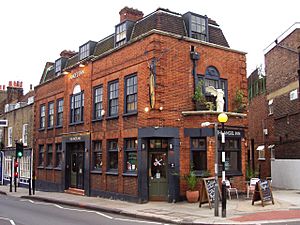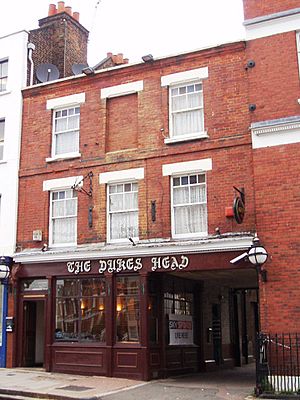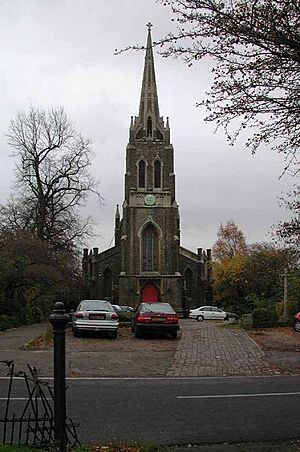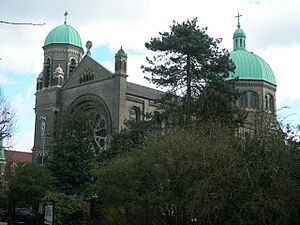Highgate facts for kids
Quick facts for kids Highgate |
|
|---|---|
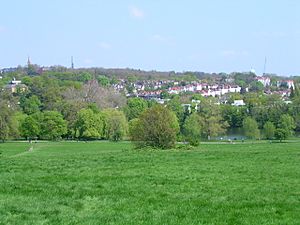 Highgate seen from Parliament Hill |
|
| Population | 10,955 (2011 Census. Ward) |
| OS grid reference | TQ285875 |
| Ceremonial county | Greater London |
| Region | |
| Country | England |
| Sovereign state | United Kingdom |
| Post town | LONDON |
| Postcode district | N6, N19 |
| Postcode district | NW5 |
| Dialling code | 020 |
| Police | Metropolitan |
| Fire | London |
| Ambulance | London |
| EU Parliament | London |
| UK Parliament | |
Highgate is a lovely suburban area in London, located at the edge of Hampstead Heath. It's about 7 kilometers (4.5 miles) north-northwest of Charing Cross, a famous spot in central London.
Highgate is known for being one of the most expensive places to live in London. People in Highgate care a lot about their area. There are groups like the Highgate Society that work to protect its special character and green spaces.
For a long time, until the late 1800s, Highgate was a separate village outside London. It sat on the main road heading north. Even today, it has many green areas. These include part of Hampstead Heath, three old woods, Waterlow Park, and the slopes known as Highgate bowl.
At the heart of Highgate is its village center. Here you'll find many Georgian-style shops, pubs, and restaurants. There are also interesting buildings like St Michael's Church with its tall steeple, and St. Joseph's Church with a green copper dome. Other landmarks include Highgate School (founded in 1565) and Jacksons Lane arts center. The Gatehouse Inn, built in 1670, is home to the theatre Upstairs at the Gatehouse. You can also see Berthold Lubetkin's modern Highpoint buildings from the 1930s. Pond Square is a registered village green and a hub for community events. These events often happen in the beautiful buildings of the Highgate Literary and Scientific Institution.
Highgate is most famous for the Victorian Highgate Cemetery. Many well-known people are buried there, including the philosopher Karl Marx and the writer George Eliot. Next to the cemetery is Holly Village, which was one of the first gated communities. It was built in 1865 and is a very important historical site.
The village sits at the top of Highgate Hill. From here, you can enjoy amazing views across central London. Highgate's highest point is about 136 meters (446 feet) above sea level.
Highgate is split between three different London boroughs. These are Haringey (in the north and east), Camden (in the south and west), and Islington (in the south and east). The postal code for Highgate is N6.
Contents
Highgate's Name and History

Highgate has a long history. Its name comes from the past when it was next to the Bishop of London's hunting land. There was a tall, deer-proof hedge around this land, and Highgate was "the gate in the hedge."
The bishop also had a toll-house where one of the main roads out of London entered his property. Many pubs opened along this road. One of them, The Gatehouse, reminds us of the old toll-house.
Highgate School is a very old and important part of the village. It has been on its current site since Queen Elizabeth I allowed it to be built in 1565. Its red brick Victorian buildings and chapel are on Hampstead Lane and Highgate Hill.
Highgate Hill is a steep street that connects Highgate village with Archway. It was once home to Europe's first cable car. This cable car system ran from 1884 to 1909.
Like many parts of London, Highgate was damaged during World War II by German air raids. The local tube station was used as a safe place during these bombings.
Highgate New Town is a housing area built after the war. It is next to the cemetery and was designed by Camden Council.
How Highgate is Governed
Highgate is part of different areas for government. For example, for national elections, the whole of Highgate Village is now part of the Hampstead and Highgate (UK Parliament constituency). Before 2023, the southern part of Highgate was in the Holborn & St Pancras area. Its Member of Parliament (MP) is Keir Starmer, who is the current leader of the Labour Party.
Getting Around Highgate

Nearby Areas
- Archway
- Crouch End
- Dartmouth Park
- East Finchley
- Hampstead
- Hornsey
- Muswell Hill
- Tufnell Park
Bus Routes
Several London Buses routes serve Highgate Village. These include routes 143, 210, 214 (which runs 24 hours), 263, and the Night Bus N271.
Nearest Tube Stations
You can reach Highgate by using the London Underground (Tube) at these stations:
- Highgate tube station
- Archway tube station
- East Finchley tube station
Interesting Places to Visit
Highgate is famous for its many pubs along the old high street and nearby roads. Some popular ones are the Angel, the Flask, the Duke's Head, and the Wrestlers.
Other interesting places include:
- Highgate Cemetery
- Highgate Literary and Scientific Institution
- Highgate School
- Channing School
- Highgate Wood
- Kenwood House
- Highpoint I and II
- Athlone House, which was once a military intelligence school.
- Cromwell House
- Lauderdale House
- Witanhurst
- The Grove
- Archway Bridge
- St Michael's Church
- St Joseph's Church
People and Population
The 2011 census showed that most people living in Highgate were white. In the Haringey part of Highgate, about 82% were white. In the Camden part, about 80% were white. Christianity was the largest religion in both areas, followed by Judaism and Islam.
Education in Highgate
Highgate has several schools. Highgate School is a very old and famous independent school for boys and girls. Channing School is another well-known independent school for girls.
Churches in Highgate
Highgate's main Church of England church is St Michael's. It is located near the top of the hill and is the highest church in Greater London! It was built in 1831. The church's tall spire, made of special stone, is a landmark you can see from far away in London.
Inside, you can see beautiful stained glass windows. One of these was put in after the Second World War to replace a window broken during the bombings. There is also a special memorial inside for the famous poet Samuel Taylor Coleridge and his family.
Further down Highgate Hill is the Roman Catholic church, St Joseph's. It was built in 1888. This church has a unique copper dome that has turned green over time. The inside of the dome has beautiful paintings.
Famous People from Highgate
Highgate Cemetery is the final resting place for many famous people. These include the philosopher Karl Marx, scientist Michael Faraday, writer George Eliot, and singer-songwriter George Michael.
Many other notable people have lived in Highgate:
- The wife and son of Adolf Hitler's half-brother lived here in the 1930s.
- Leslie Compton, a famous football and cricket player, owned a pub in Highgate.
- Singer George Michael had a house in Highgate.
- Rock stars Rod Stewart and Ray Davies (from The Kinks) were born or lived in Highgate.
- Filmmaker Christopher Nolan grew up here.
- Actors Jude Law and Robert Powell have lived in Highgate.
- Comedian Noel Fielding lives in Highgate.
- Singer Liam Gallagher lives in Highgate.
- Comedians Graham Chapman and Terry Jones from Monty Python lived in Highgate.
Many famous people also attended Highgate School. These include the poet T.S. Eliot (who taught there), poet Gerard Manley Hopkins, and composers John Taverner and John Rutter. John Venn, who invented Venn diagrams, also went to Highgate School.
A special blue plaque on a house on North Hill shows that writer Charles Dickens stayed there in 1832 when he was 20 years old.
Samuel Taylor Coleridge
The famous poet Samuel Taylor Coleridge lived in Highgate for many years. While he was here, some of his most well-known poems, like "Kubla Khan", were first published. His important book about his life and writing, Biographia Literaria, came out in 1817. His home became a place where other famous writers, like Thomas Carlyle and Ralph Waldo Emerson, would visit him. He passed away in Highgate on July 25, 1834, and is buried in the crypt of St Michael's Church.
Highgate in Movies and Books
Highgate's historic feel, especially its spooky cemetery, has been used as a setting in many films. These include old Hammer Horror movies from the 1970s and more recent films like Fantastic Beasts: The Crimes of Grindelwald and Dorian Gray.
- The old pub tradition of Swearing on the Horns started in Highgate.
- In Charles Dickens' novel David Copperfield, a character named James Steerforth lives in Highgate.
- In the BBC TV show Are You Being Served?, the character Mr Lucas lives in Highgate.
- Taylor Swift mentions Highgate in her song "London Boy" from her 2019 album Lover.
- In Robert Galbraith's book The Ink Black Heart, a murder happens in Highgate Cemetery.
|
See also
 In Spanish: Highgate para niños
In Spanish: Highgate para niños




